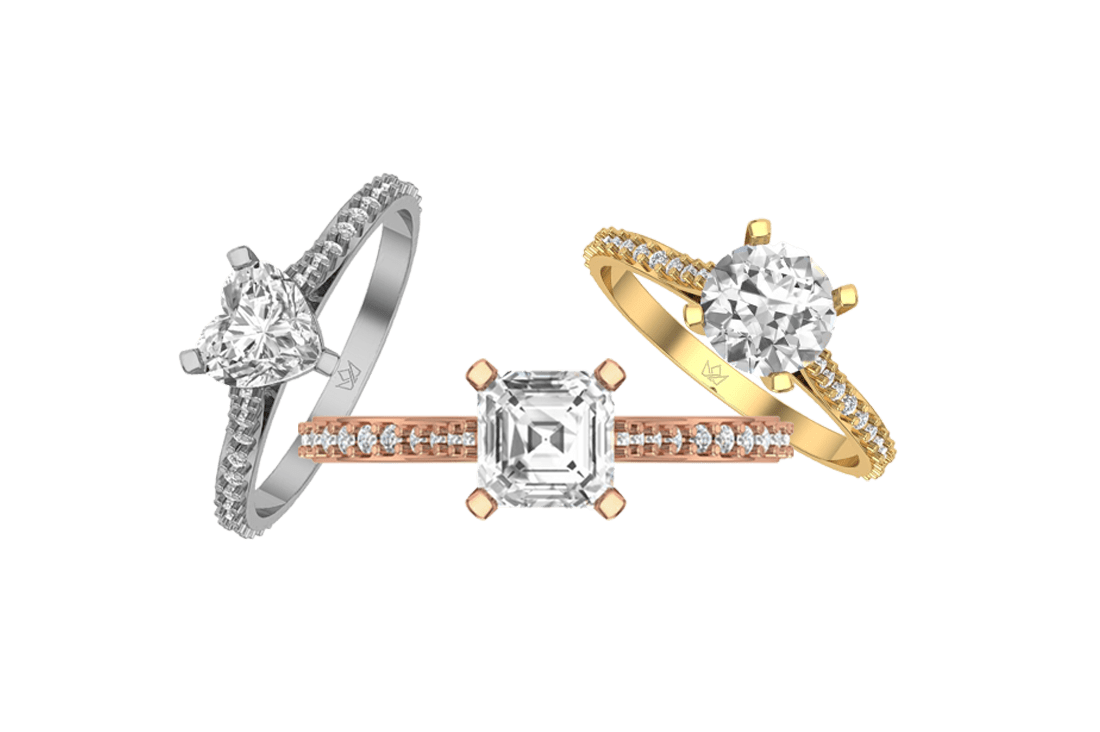

What is A Carat?
In 1907, the carat was adopted as the unit of weight for diamonds. Prior to that, standards varied over the world and were country-specific for gemstone appraisal.
The specific weight measuring unit known as a carat (ct.) is only used to weigh gemstones and diamonds. Despite being a weight measurement, carat weight is frequently confused with visual size. Carat weight cannot be seen with the unaided eye. Density, the composition of the jewel, and the shape are only a few of the elements that determine a stone’s weight.
A large carat count does not necessarily correspond to a large stone. The weight will manifest itself visually differently depending on the type and shape of the gemstone being weighed. For instance, a 1.00 ct. round sapphire will be about 6.0mm in diameter and a 1.00 ct. round diamond will be about 6.5mm. This is a result of the differing densities of various gemstones.
Total Carat Weight, sometimes known as TCW, is a term to check for when shopping. When more than one stone is used in a piece of jewellery, the total carat weight refers to the combined weight of all the diamonds or other gemstones in that item. TCW is frequently used in the sale of jewellery sets and jewellery sold in pairs. For instance, the total carat weight (TCW) of diamond solitaire earrings often refers to the total weight of the diamonds in both earrings.
Diamond Size Chart
Our Diamond Size Chart shows what different diamond shapes look like depending on carat weight. Each image shows what it looks like when viewing the diamond from the top down.
The diamonds in our Diamond Size Chart may appear to be different sizes, but the carat weight is still the same. For example, the 1-carat radiant diamond looks smaller than the 1-carat pear diamond, yet they are the same carat weight.
How Diamond Carat Is Weighed
Carat is derived from the carob seed. Because carob seeds were uniform in weight and size, gem merchants used them to help weigh gemstones and diamonds in the past.
A carat is now roughly the weight of a paperclip – 0.2 grams, or 200 milligrams. Carat weight is a universal measurement, regardless of the measurement system a country employs.
To determine the carat of a diamond, first weigh it and use grams as the unit of measurement. Once you’ve determined how much the diamond weighs, divide that figure by 0.2 to get the carat weight. Most modern jewellers do not calculate carat weight by hand; instead, they weigh gemstones on a specific scale. These scales were designed specifically for measuring carat weight.
A point system is also used by gemmologists and jewellers to refer to diamond carat weight. The following is how it works:
- 25 points = 0.25 carat
- 75 points = 0.75 carat
- 150 points = 1.50 carat
- 400 Points = 4.00 carat
And so on.


How Important Should Diamond Carat Size Be When Buying A Diamond?
Carat weight is important, but it is not the only factor to consider when purchasing a diamond. Carat weight is only as important to the buyer as they make it. There is no universally accepted carat weight; it is subjective and is determined primarily by what qualities are important to each individual.
The Five C’s are not in any particular order, but each has an impact on the value and beauty of a diamond. When looking for the perfect diamond, keep the person who will be receiving it in mind. If the recipient prefers sparkly, eye-catching jewellery, you should consider cut, clarity, and colour rather than carat weight. Carat weight and cut should be focal points if the recipient is concerned with visual size.




How Diamond Carat Impacts Price
The carat weight of a diamond is one of the most important factors in determining its price. Once the cut, colour, and clarity grade of a diamond have been determined, the carat weight can be easily determined to fit within a budget.
Larger diamonds are far more valuable than smaller diamonds because they are discovered in nature far less frequently. As a result, diamonds are not priced linearly. In other words, a one-carat diamond is more expensive than two half-carat diamonds of the same quality. The general rule of thumb for diamond pricing is that double the carat weight equals four times the price. As a result, purchasing jewellery with multiple diamonds of lower carat weight may be less expensive than purchasing jewellery with a single diamond of higher carat weight.
1.25 ct. and 1.0 ct. are the most popular carat weights. However, if you want to save money, look for a slightly lower carat diamond with an excellent cut. A well-cut diamond can help a diamond appear larger.
Some diamonds fall into what jewellers call “under-size” categories, which means they weigh just below a cut-off weight. The cut-off weights are 0.50 carat, 0.75 carat, 0.90 carat, 1.00 carat, 1.50 carat, and 2.00 carat. Under-sized diamonds are more difficult to find because a diamond cutter will choose to sacrifice beauty in order to cut a diamond with a weight that reaches one of the cut-off weights, also known as “magic numbers” in the industry. Having said that, seemingly insignificant carat weight differences have a significant impact on cost. So looking for a smaller diamond could help you save money.
Approximate Carat Weight Size
This diagram illustrates the typical size relationship between diamonds of increasing carat weights. While the measurements below are typical, every diamond is unique.




